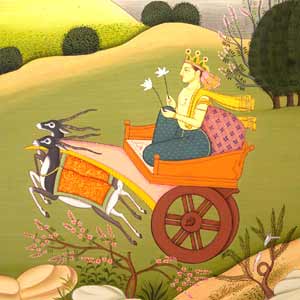Contribute
| South Asian Art - In Memory Of Prashant H. Fadia |
Ranjani Saigal
06/25/2008
Various schools of miniature painting collectively called Pahari, flourished between the 17th and 19th centuries in the sub-Himalayan states towards the end of the Mughal rule in India. Rajput kings or chieftains who were all great connoisseurs of art ruled the hilly region, comprising of 22 princely states, extending from Jammu to Almora. With the infusion of new ideas and techniques these schools attained a level of maturity and sophistication, which made them worthy successors of the Mughal tradition. This art dwelt largely on the themes and symbols from literature and mythology. A typical Pahari composition consists of several figures skillfully grouped and full of movement, and each is distinctive in terms of clothing, hairstyle and even pigmentation, which may be blue, white, pink or grey. Pandit Seu of Guler and his sons Manaku and Nainsukh were among the greatest of the Pahari painters.
Pahari painting had two principal phases of development . The earlier phase that started from the mid 17th century in Basholi region is extraordinarily colorful with its primitive expressions charged with vitality and emotional intensity. These early pahari paintings can be distinguished by fish – shaped elongated eyes, oval faces , receding foreheads ,round chins and prominent noses. Bold figures are carefully laid against monochrome backgrounds of red ,yellow, green or brown colours. Decorative pigmy trees suggest the feeling of perspective while the sky is indicated only by a narrow strip on the horizon.
The style underwent a change in the second quarter of the 18th century and a new phase developed in the Guler area. The paintings of this phase are done in a somewhat naturalistic manner. The vitality of the line toned down and acquires a lyrical character ; The line now seem to be flowing in a rhythmic way. The colour scheme also became slightly cooler and freshness in colour and delicacy in execution particularly in case of Guler-kangra schools is remarkable . The new style of eighteenth century dominated almost all the Guler – Kangra style exhibit more vegetation and green expanses . Besides , the brooks and the rivulets became common elements of printings done in Kangra valley. The refined style of Guler Kangra is distinguished by its graceful female facial types . The round sharp- featured female faces are rendered with great care by the accomplished Pahari Artists.The feminine beauty is highly idealized in the Guler – Kangra style. This style was significantly impacted by the Bhakti movement.
The royalty at this time commissioned texts based on love themes and stories of Krishna. Gita Govinda (the Divine Love Song) and the tenth book of the Bhagavata Purana (the stories of Krishna) provided evergreen themes. While the Aranya Kanda, and the Lanka Kanda of Ramayana epic were repeatedly illustrated.
One of the early notable works of art was Devi Mahatmya manuscript, painted at Kangra in 1552. Besides this, Rasamanjiri, a 15th century Sanskrit text, penned down by Bhanudaata of Mithila in Bihar, was a significant illustrated work. The heroes (nayakas) and heroines (nayikas) and beauteous maidens of this rhetoric text personified subtle ecstasies of romance.
The activity of the Pahari painting continued till the close of the 19th century . The changes in this period reflect degenerating standards because of the prevailing political conditions .
The last phase of Pahari painting is generally Known as the ‘sikh School’ . This style lacks the real refinement and the aesthetic merit of Kangra Kalam , However , it is considered as the last destination of the art of Pahari miniatures . The Bhuri Singh Musuem in Chamba is one of the best –Known Museums famous for its exquisite collection of Pahari miniatures.
You may also access this article through our web-site http://www.lokvani.com/
